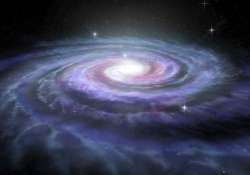Black hole producing mysterious particles: NASA
Washington: The giant black hole at the center of the Milky Way may be producing mysterious particles called neutrinos, say NASA scientists.Neutrinos are tiny particles that carry no charge and interact very weakly with electrons

Washington: The giant black hole at the center of the Milky Way may be producing mysterious particles called neutrinos, say NASA scientists.
Neutrinos are tiny particles that carry no charge and interact very weakly with electrons and protons.
Unlike light or charged particles, neutrinos can emerge from deep within their cosmic sources and travel across the universe without being absorbed by intervening matter or, in the case of charged particles, deflected by magnetic fields.
"Figuring out where high-energy neutrinos come from is one of the biggest problems in astrophysics today," said Yang Bai from University of Wisconsin in Madison.
"We now have the first evidence that an astronomical source - the Milky Way's supermassive black hole - may be producing these very energetic neutrinos,” he noted.
The Earth is constantly bombarded with neutrinos from the sun.
However, neutrinos from beyond the solar system can be millions or billions of times more energetic.
Scientists have long been searching for the origin of ultra-high energy and very high-energy neutrinos.
Scientists think that the highest energy neutrinos were created in the most powerful events in the Universe like galaxy mergers, material falling onto supermassive black holes and the winds around dense rotating stars called pulsars.
Because neutrinos pass through material very easily, it is extremely difficult to build detectors that reveal exactly where the neutrino came from.
The IceCube Neutrino Observatory, located under the South Pole, has detected 36 high-energy neutrinos since the facility became operational in 2010.
This latest result may also contribute to the understanding of another major puzzle in astrophysics: the source of high-energy cosmic rays.
The results appeared in the journal Physical Review D.